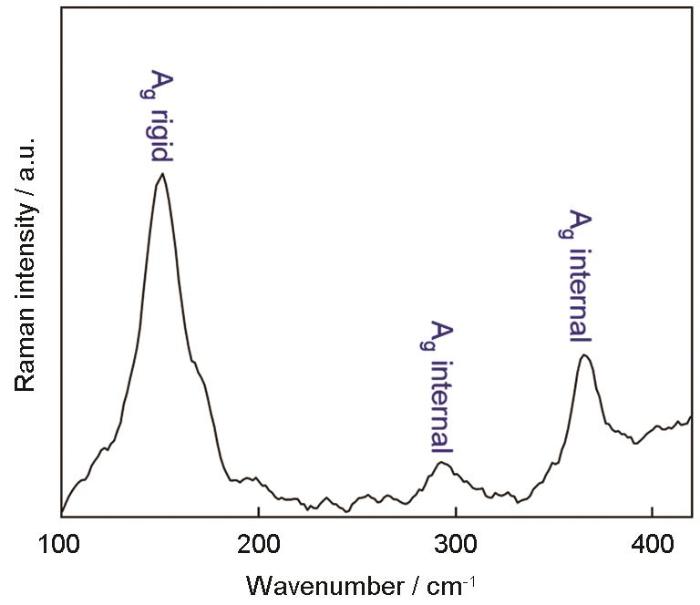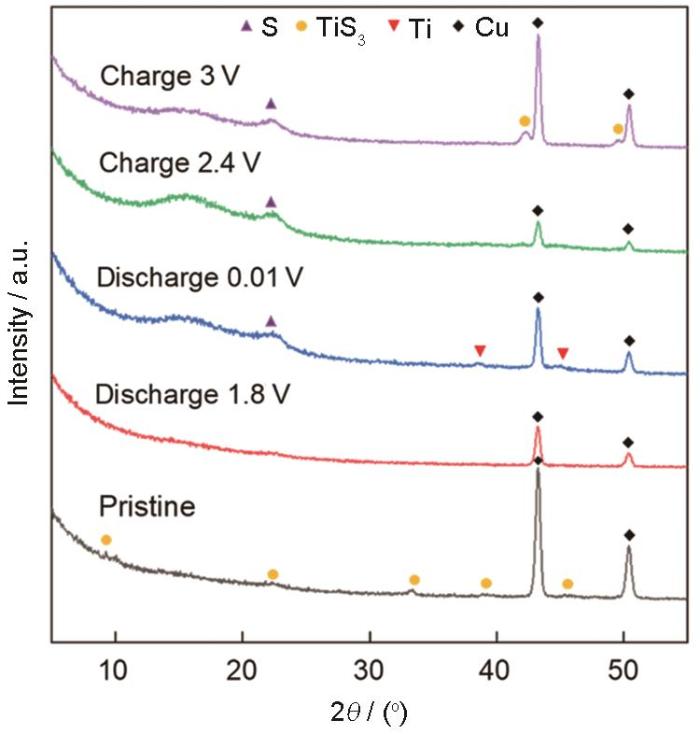作为转化反应型负极材料的过渡金属硫化物,其比容量较高。二维层状过渡金属硫属化物(TMDCs)是一种典型的MX2型负极材料[9],得到了广泛的应用[10~12]。这类过渡金属硫属化物材料作为锂离子电池负极,其理论比容量较高[13~15]。但是,过渡金属二硫化物类型的二维层状材料在快速充放电过程中或在电流密度较大的情况下其层状结构可能崩塌[16]。与其相比,具有不同结构的过渡金属三硫化物(TMTCs)具有较高的比容量[17,18]。TiS3是一种典型的过渡金属三硫化物,TiS3分子中的两个硫原子一个以S22-的形式存在,另一个以S2-的形式存在[19]。过渡金属三硫化物通过弱范德华键和强共价键连接,但是共价键所结合的基本结构不是TMTCs的一层而是一维链。这些链通过较弱的范德华力结合成为二维层状形态,再由这些层堆叠成三维棱柱结构的晶体。
1 实验方法
1.1 TiS3 纳米粒子的制备
先用直流电弧等离子体法制备TiH1.924作为前驱体:使用纯度为99.99%金属钛块作为负极,用钨棒作为正极,将直流电弧等离子体设备腔体的真空度抽至- 0.102 MPa后通入压力为0.03 MPa的氩气和0.02 MPa的氢气。在电流为80 A电压为25 V的条件下起弧制备纳米粉体。20 min后断弧,6 h后向直流电弧等离子体设备粉体制备室中通入0.005 MPa的空气进行钝化,约12 h后打开设备收集腔体内的TiH1.924纳米粉体。
将制备好的TiH1.924纳米粒子以1∶4的质量比与升华硫混合均匀(升华硫过量),将其置于玻璃管内并通入氩气作为保护气,然后将玻璃管真空密封。再将密封后的玻璃管置于真空管式炉恒温区。将管式炉以10℃/min速率加热到400℃,保温120 min后随炉冷却,待管式炉的恒温区温度降至室温后取出样品。将得到的样品充分研磨后放入石英舟中,再将石英舟置于管式炉恒温区并抽真空后通入氩气保护,在200℃保温180 min后随炉冷却,待管式炉恒温区温度降至室温后取出TiS3纳米粒子样品。
1.2 TiS3 纳米粒子的性能表征
用XRD-6000X射线衍射仪分析样品的物相组成,扫描范围5°~90°;用SU8220扫描电子显微镜(SEM)和Tecnai G2 F30场发射透射电子显微镜(TEM)观察样品的微观形貌特征。用原子力显微镜(AFM,DI-Multi-mode NS3A-02)测试样品的性能。用InVia拉曼光谱仪测试粉体的拉曼光谱,激发波长为532 nm。
将TiS3纳米粉末与导电剂(Super-P) 导电炭黑、粘结剂(聚丙烯酸)按照7∶2∶1的质量比混合后在研钵中研磨均匀,在研磨过程中逐滴加入适量的N-甲基吡咯烷酮(NMP)直至浆料粘稠度适中。将浆料涂覆于铜箔上并在涂覆机中初步烘干,待冷却后将其置于恒温真空干燥箱中,在90℃干燥10 h,冷却后取出。将完全干燥的铜箔冲裁成直径为14 mm的圆形电极片并称量每个电极片的质量。在充满氩气保护气的手套箱中,以锂片为对电极、以1 mol/L LiPF6/EC+DE+FEC作为电解液组装CR2025纽扣电池。使用LAND CT2001A蓝电测试系统和CHI660E电化学工作站测试电池的电化学性能。
2 结果和讨论
2.1 TiS3 纳米粒子的形貌和结构
图1给出了TiS3的晶体结构示意图。TiS3分子中有3个硫原子,其中的两个以S22-的形式存在,另一个以S2-的形式存在。图2给出了钛氢化合物和TiS3纳米粉体的XRD衍射谱。图2a给出了钛氢化合物的XRD谱与TiH1.924的标准PDF卡片(JCPDS No.00-025-0982)对比,谱中的衍射峰分别对应(111), (200),(220),(311)和(222)晶面,钛氢化合物与TiH1.924的标准PDF卡片的特征峰一致。这表明,使用直流电弧等离子体法成功地制备出TiH1.924纳米粒子。图2b给出了TiS3纳米粉体的XRD图谱与TiS3的标准PDF卡片(JCPDS No.00-015-0783)对比,谱中的衍射峰分别对应(001),(101),(003),(012),(-201),(201),(013),(210)和(-105)晶面。图3给出了TiS3纳米材料的拉曼谱,可见在153、291和363 cm-1处出现三个明显的特征峰,与文献报道的TiS3特征峰一致[30]。153 cm-1处的峰与TiS3中的刚性链振动相关,291和363 cm-1处的峰与构成每个TiS3的每个单层的内部面外振动相关。拉曼图谱和XRD谱表明,本文在实验中成功地制备出单相TiS3晶体。
图1
图2
图3
图4
图4
TiH1.924和TiS3的SEM和TEM照片
Fig.4
SEM (a) and TEM images (c) of TiH1.924 and SEM (b) and TEM images of TiS3 (d, e)
图5
图5
TiS3纳米片的TEM、AFM照片以及厚度示意图
Fig.5
TEM (a) andAFM images (b) of TiS3 andthe thickness of TiS3 nanosheets (c~d)
2.2 TiS3 电极的电化学性能
图6a给出了TiS3纳米片状结构电极的循环性能曲线。在电流密度为500 mA/g的条件下,电池的首次放电容量为839.7 mAh/g,首次充电容量为639.8 mAh/g,对应的库伦效率为76.2%。经过300次循环后电池的比容量保持在430 mAh/g左右,放电容量保持率为67.1%,库伦效率稳定在99%左右。图6b给出了TiS3负极材料在100、200、500 mA/g、1、2、5 A/g电流密度条件下的倍率性能曲线。可以看出,电流密度为5 A/g时TiS3负极材料的比容量仍能保持在280 mAh/g左右。TiS3负极经过大电流密度充放电后,电流密度为100 mA/g时电池的比容量稳定在600 mAh/g左右。这表明,与初始的在100 mA/g电流密度下测得的容量相比,容量保持率较高。
图6
图6
TiS3纳米粉体的充放电曲线和倍率性能曲线
Fig.6
Cycling performance of TiS3 nano powder at 500 mA/g (a) and rate performance (b) of TiS3 nanosheet
图7
图7
TiS3电极片循环前和循环500圈后的SEM照片
Fig.7
SEM image of TiS3 electrode (a) before cycle, (b) after 500 cycles
图8
图8
TiS3纳米粉体的充放电曲线和CV曲线
Fig.8
Charge/discharge voltage-specific capacity curves of TiS3 nano powder (a) and cyclic voltammograms of TiS3 nano powder (b)
在1.2 V和0.3 V处出现的峰,可能与SEI膜的生成有关。在1.8 V处只在第一次放电时出现平台,与进一步锂化后的复杂相变有关。在2.2 V、1.6 V和0.6 V处出现的放电平台,可归结为Li+离子嵌入TiS3中发生的多步反应。首次充电时,在1.4 V、1.9 V、2.4 V和2.5 V附近出现了明显的电压平台。2.4 V处的电压平台,可归因于合成TiS3反应过程中去硫时残留的少量硫单质。循环3圈后2.4 V的峰消失,此时少量的非晶态S发生了不可逆的反应[33]。
图9给出了TiS3电极在不同的充放电循环过程中的非原位XRD谱。根据初始状态电极片的非原位XRD测得的物质为TiS3;电池放电至1.8 V时TiS3的峰消失,对应锂离子嵌入TiS3生成了非晶态LixTiS3,因此非原位XRD上没有出现明显的峰;当电池放电至0.01 V时,与放电至1.8 V相比,在15°附近出现了馒头状的峰,在23°附近出现了较宽的衍射峰,可归结为结晶性不好的S单质,在38°和44°出现的两个峰可归结为Ti单质的形成。这表明,在TiS3纳米片负极放电完全的情况下,有单质Ti和单质S生成[33]。当电池充电至2.4 V时,单质Ti和单质S与Li重新结合生成Li x TiS3。这种物质可能是非晶态的,因此在XRD谱中没有明显的峰;当电池充电至3 V时XRD谱中的两个峰,可归结为TiS3的生成。经过充放电循环电极材料仍为TiS3,表明这种材料具有良好的可逆性。在43°和50°出现的两个较强峰,可归结为负极集流体中的Cu。
图9
图9
TiS3电极片在充放电过程中的非原位XRD谱
Fig.9
Ex situ XRD pattern from 5° to 55° of TiS3 electrodes at different discharge-charge states
2.3 电化学阻抗谱
可以计算出Warburg系数σW、锂离子扩散系数D0以及法拉第电流密度。式中R为理想气体常数(8.314 J·mol-1·K-1),T为室温(298 K),A为电解质和电极之间的接触面积(1.54 cm2),n为电极发生的氧化还原反应中每摩尔活性物质转移的电子数,F为法拉第常数(96500 C·mol-1),C为Li+的浓度(1 mol·L-1)。
图10
图10
TiS3电极循环不同次数后的电化学阻抗谱
Fig.10
EIS curves of the TiS3 electrode after different number of cycles (a) before cycle、1st cycle、5th cycle, (b) before cycle、10th cycle、20th cycle、50th cycle
图11
图11
TiS3电极材料循环前和循环后电化学阻抗谱的等效电路模拟
Fig.11
Equivalent analog circuits of TiS3 electrode before cycle (a) and after cycle (b)
表1 TiS3纳米片电极的模拟电路参数
Table 1
| Sample | CPE1 | CPE2 | R2 | R3 | σW/Ω·cm2·s-0.5 | D0/cm2·s-1 | IF/mA·cm-2 |
|---|---|---|---|---|---|---|---|
| Initial | 3.561×10-5 | - | 62.63 | - | 28.986 | 6.366×10-11 | 2.665×10-4 |
| 1st cycle | 5.355×10-4 | 1.371×10-4 | 11.98 | 28.16 | 40.987 | 3.184×10-11 | 1.393×10-3 |
| 5th cycle | 2.766×10-4 | 1.056×10-7 | 23.64 | 0.809 | 31.275 | 5.468×10-11 | 7.061×10-4 |
| 10th cycle | 1.217×10-4 | 1.969×10-6 | 19.05 | 1.595 | 24.712 | 8.759×10-11 | 8.763×10-4 |
| 20th cycle | 1.476×10-4 | 1.413×10-6 | 20.84 | 1.600 | 41.579 | 3.094×10-11 | 8.010×10-4 |
| 50th cycle | 1.333×10-4 | 6.508×10-7 | 27.51 | 1.572 | 48.890 | 2.237×10-11 | 6.149×10-4 |
可以看出,循环未开始时电池的电荷转移阻抗(R2)较大,因为TiS3是一种导电性能较差的半导体材料。在第一次循环后测得的阻抗高频区有两个明显的半圆,第一个半圆归因于首次循环时生成的SEI膜,第二个半圆为电解液浸入电极材料内部。从表1可以看出,从循环第1圈到第10圈,D0和IF不断增大。其原因是,随着循环数的增加SEI膜的生成和电解液浸入电极材料内部,促进了锂离子的扩散和迁移。从循环第10圈到第50圈,随着循环次数的增加R3的值变化很小,表明已经生成了完整的SEI膜。而IF的值不断减小,其原因可能是TiS3在循环过程中分解生成不导电的S,从而降低了电极的导电性。
3 结论
(1) 先用直流电弧等离子体蒸发法制备前驱体TiH1.924,然后进行简单的固-气相反应可制备出片状TiS3纳米粒子。与传统的将Ti与S混合作为前驱体制备TiS3材料的方法相比,将纳米TiH1.924颗粒与硫混合加热能很好地控制TiS3纳米片的尺寸,反应时间也大幅度缩短。
(2) TiS3纳米片能适应充放电过程中发生的体积变化。使用厚度约为35 nm纳米片负极的电池,在电流密度为100 mA/g时循环300圈后其容量仍约为450 mAh/g。当电流密度为5 A/g时其放电比容量保持在240 mAh/g,电流密度降低到100 mA/g则其放电比容量稳定在500 mAh/g。
(3) 这种TiS3纳米片锂离子电池负极材料的电化学性能良好,且其制备工艺简单、成本较低。
参考文献
Issue and challenges facing rechargeable thin film lithium batteries
[J].
Lithium batteries and cathode materials
[J].
Fundamental scientific aspects of lithium batteries (Ⅷ)——Anode electrode materials
[J].
锂离子电池基础科学问题(Ⅷ)——负极材料
[J].
Towards greener and more sustainable batteries for electrical energy storage
[J].Ever-growing energy needs and depleting fossil-fuel resources demand the pursuit of sustainable energy alternatives, including both renewable energy sources and sustainable storage technologies. It is therefore essential to incorporate material abundance, eco-efficient synthetic processes and life-cycle analysis into the design of new electrochemical storage systems. At present, a few existing technologies address these issues, but in each case, fundamental and technological hurdles remain to be overcome. Here we provide an overview of the current state of energy storage from a sustainability perspective. We introduce the notion of sustainability through discussion of the energy and environmental costs of state-of-the-art lithium-ion batteries, considering elemental abundance, toxicity, synthetic methods and scalability. With the same themes in mind, we also highlight current and future electrochemical storage systems beyond lithium-ion batteries. The complexity and importance of recycling battery materials is also discussed.
Electrical Energy Storage for the Grid: A Battery of Choices
[J].The increasing interest in energy storage for the grid can be attributed to multiple factors, including the capital costs of managing peak demands, the investments needed for grid reliability, and the integration of renewable energy sources. Although existing energy storage is dominated by pumped hydroelectric, there is the recognition that battery systems can offer a number of high-value opportunities, provided that lower costs can be obtained. The battery systems reviewed here include sodium-sulfur batteries that are commercially available for grid applications, redox-flow batteries that offer low cost, and lithium-ion batteries whose development for commercial electronics and electric vehicles is being applied to grid storage.
Energy distributions exhibited during thermal runaway of commercial lithium ion batteries used for human spaceflight applications
[J].
On the correlation between surface chemistry and performance of graphite negative electrodes for Li ion batteries
[J].
Insertion Electrode Materials for Rechargeable Lithium Batteries
[J].
The chemistry of two-dimensional layered transition metal dichalcogenide nanosheets
[J].Ultrathin two-dimensional nanosheets of layered transition metal dichalcogenides (TMDs) are fundamentally and technologically intriguing. In contrast to the graphene sheet, they are chemically versatile. Mono- or few-layered TMDs - obtained either through exfoliation of bulk materials or bottom-up syntheses - are direct-gap semiconductors whose bandgap energy, as well as carrier type (n- or p-type), varies between compounds depending on their composition, structure and dimensionality. In this Review, we describe how the tunable electronic structure of TMDs makes them attractive for a variety of applications. They have been investigated as chemically active electrocatalysts for hydrogen evolution and hydrosulfurization, as well as electrically active materials in opto-electronics. Their morphologies and properties are also useful for energy storage applications such as electrodes for Li-ion batteries and supercapacitors.
Preparation and electrochemical properties of TiS2 nanoparticle porous anode materials
[J].
TiS2纳米片多孔负极材料的制备及其电化学性能
[J].
Growth of noble metal nanoparticles on single-layer TiS2 and TaS2 nanosheets for hydrogen evolution reaction
[J].
Bifunctional TiS2/CNT as efficient polysulfide barrier to improve the performance of lithium-sulfur battery
[J].
Rational design of strong chemical coupling carbon coated N-doped C@MoS2@C nanotubes for high-performance lithium storage
[J].
Two dimensional graphene-SnS2 hybrids with superior rate capability for lithium ion storage
[J].
Electrospun SnSe/C nanofibers as binder-free anode for lithium-ion and sodium-ion batteries
[J].
Two-Dimensional Materials for Beyond-Lithium-Ion Batteries
[J].
All-solid-state sodium batteries using amorphous TiS3 electrode with high capacity
[J].
Controlling Sulfur Vacancies in TiS2-x Cathode Insertion Hosts via the Conversion of TiS3 Nanobelts for Energy-Storage Applications
[J].
Study on photoelectric characteristics of narrow-band and wide-band oxide radial heterostructures
[D].
窄带宽带氧化物径向异质纳米结构光电特性研究
[D].
An ab initio study of TiS3: a promising electrode material for rechargeable Li and Na ion batteries
[J].
Recent developments in nanostructured anode materials for rechargeable lithium-ion batteries
[J].
Nanostructured Materials for Advanced Energy Conversion and Storage Devices
[J].New materials hold the key to fundamental advances in energy conversion and storage, both of which are vital in order to meet the challenge of global warming and the finite nature of fossil fuels. Nanomaterials in particular offer unique properties or combinations of properties as electrodes and electrolytes in a range of energy devices. This review describes some recent developments in the discovery of nanoelectrolytes and nanoelectrodes for lithium batteries, fuel cells and supercapacitors. The advantages and disadvantages of the nanoscale in materials design for such devices are highlighted.
Electromagnetic Response and Energy Conversion for Functions and Devices in Low‐Dimensional Materials
[J].
Hollow nanoparticle-assembled hierarchical NiCo2O4 nanofibers with enhanced electrochemical performance for lithium-ion batteries
[J].
Hierarchical three-dimensional flower-like Co3O4 archi- tectures with a mesocrystal structure as high capacity anode materials for long-lived lithium-ion batteries
[J].
TiS3 Transistors with Tailored Morphology and Electrical Properties
[J].
All-solid-state sodium batteries using amorphous TiS3 electrode with high capacity
[J].
Titanium Tri- and di-Sulfide Nanobelts/Graphene Composites for Rechargeable Lithium Battery Cathodes and Enhancement of Reversible Capacities
[J].
Quasi-1D TiS3: A potential anode for high-performance sodium-ion storage
[J].
Preparation and electrochemical behaviors of MoP banoparticles as anode material for lithium-ion batteries
[J].
MoP纳米粒子锂离子电池负极材料的制备及其电化学性能
[J].用直流电弧等离子体法制备金属钼纳米粉体再使其与赤磷发生固相反应,用两步法制备出磷化钼纳米粒子。使用X射线衍射(XRD)和透射电镜(TEM)等手段表征磷化钼纳米粒子的结构并进行了电化学性能测试。结果表明,MoP纳米粒子呈球状,粒径为20~50 nm;在电流密度为100 mA/g的条件下MoP纳米粒子负极材料的首次放电比容量达到746 mAh/g,50次循环后放电比容量为241.9 mAh/g;电流密度为2000 mA/g时放电比容量为99.90 mAh/g,电流密度恢复到100 mA/g其放电比容量仍然保持247.60 mAh/g。用作锂离子电池的负极材料,MoP纳米粒子具有优异的稳定性和可逆性。
Unusual lattice vibration characteristics in whiskers of the pseudo-one-dimensional titanium trisulfide TiS3
[J].Transition metal trichalcogenides form a class of layered materials with strong in-plane anisotropy. For example, titanium trisulfide (TiS3) whiskers are made out of weakly interacting TiS3 layers, where each layer is made of weakly interacting quasi-one-dimensional chains extending along the b axis. Here we establish the unusual vibrational properties of TiS3 both experimentally and theoretically. Unlike other two-dimensional systems, the Raman active peaks of TiS3 have only out-of-plane vibrational modes, and interestingly some of these vibrations involve unique rigid-chain vibrations and S-S molecular oscillations. High-pressure Raman studies further reveal that the A(g)(S-S) S-S molecular mode has an unconventional negative pressure dependence, whereas other peaks stiffen as anticipated. Various vibrational modes are doubly degenerate at ambient pressure, but the degeneracy is lifted at high pressures. These results establish the unusual vibrational properties of TiS3 with strong in-plane anisotropy, and may have relevance to understanding of vibrational properties in other anisotropic two-dimensional material systems.
Anionic Redox Chemistry in Polysulfide Electrode Materials for Rechargeable Batteries
[J].
Lithium-Sulfur Batteries: Electrochemistry, Materials, and Prospects
[J].
















